
Drosera, which is commonly known as the sundews, is one of the largest genera of carnivorous plants, with at least 194 species. These members of the family Droseraceae lure, capture, and digest insects using stalked mucilaginous glands covering their leaf surfaces. The insects are used to supplement the poor mineral nutrition of the soil in which the plants grow. Various species, which vary greatly in size and form, are native to every continent except Antarctica.

Drosera rotundifolia, the round-leaved sundew, roundleaf sundew, or common sundew, is a carnivorous species of flowering plant that grows in bogs, marshes and fens. One of the most widespread sundew species, it has a circumboreal distribution, being found in all of northern Europe, much of Siberia, large parts of northern North America, Korea and Japan but is also found as far south as California, Mississippi and Alabama in the United States of America and in New Guinea.

Drosera spatulata, the spoon-leaved sundew, is a variable, rosette-forming sundew with spoon-shaped leaves. The specific epithet is Latin for "spatula shaped," a reference to the form of the leaves. This sundew has a large range and occurs naturally throughout Southeast Asia, southern China and Japan, Micronesia, Papua New Guinea, eastern Australia, Tasmania and New Zealand. Variants are often known by the localities in which they are found. The plant does not form hibernacula in winter, and is easily grown using the same methods as Drosera capensis.
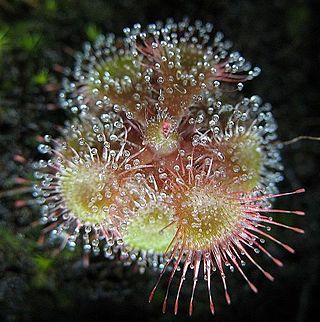
Drosera burmanni, the tropical sundew, is a small, compact species in the carnivorous plant genus Drosera. Its natural geographical range includes the tropical and subtropical regions of Asia and Australia. It normally spans only 2 cm (0.8 in) in diameter. It is one of the fastest trapping sundews as well, and its leaves can curl around an insect in only a few seconds, compared to the minutes or hours it takes other sundews to surround their prey. In nature, D. burmanni is an annual, but in cultivation, when grown indoors during the cold months, it can live for many years. Since D. burmanni is an annual, it produces large amounts of seed. Drosera burmanni has been considered a powerful rubefacient in Ayurveda.

Drosera ordensis is a species of sundew, native to Australia and part of the "petiolaris complex" of sundews making up the subgenus Lasiocephala. Compared to many petiolaris sundews, it has wide petioles, which are densely covered in silvery hairs. It usually forms rosettes 8 cm across, although plants up to 20 cm in diameter have been reported.

Drosera indica, sometimes known as the Indian sundew, is a species of sundew native to tropical and southern Africa, Madagascar and tropical and subtropical Asia. It was first described by Carl Linnaeus in his Species Plantarum in 1753. Until the early 21st century it was mostly considered a highly variable species with a wide distribution including Australia, but since 2000 several distinct species have been separated from D. indica within Drosera section Arachnopus, which is often referred to as the ‘Drosera indica complex’. Many of these species are endemic to Australia, but D. indica itself is now widely considered to be absent from that country.

Drosera whittakeri is a sundew that is native to South Australia and Victoria.

Drosera orbiculata is a perennial tuberous species in the genus Drosera that is endemic to Western Australia. It grows in a rosette about 1.5 cm in diameter. It is native to an area 1.3 km north of Gillingarra near Perth. It grows in sandy clay soils in winter-wet depressions and washes. It is considered to be related to D. rosulata. The species is named for the shape of the leaf lamina. It was first formally described by Allen Lowrie and N. G. Marchant in 1992.

Drosera erythrorhiza, the red ink sundew, is a perennial tuberous species in the carnivorous plant genus Drosera that is endemic to Western Australia. It grows in a rosette and is distinguished from the other species in section Erythrorhiza by its many-flowered cymose inflorescences with up to 50 individual flowers. D. erythrorhiza was first described by John Lindley in his 1839 publication A sketch of the vegetation of the Swan River Colony. In 1992, N. G. Marchant and Allen Lowrie described three new subspecies, thus also creating the autonym D. erythrorhiza subsp. erythrorhiza. The subspecies were separated from this variable species mostly by leaf morphology and distribution.
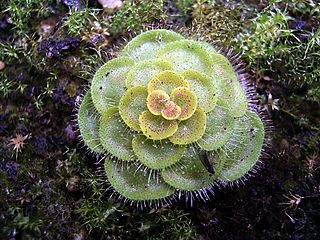
Drosera zonaria, the painted sundew, is a perennial tuberous species in the carnivorous plant genus Drosera and is endemic to south-west Western Australia from near Perth southeast to near Esperance. It grows in a tight rosette approximately 5 to 7 cm in diameter with 20 to 30 green to red leaves that are arranged in concentric layers. The leaves are typically 1 cm wide and are usually described as being "kidney-shaped" with crimson leaf margins. It grows in deep silica sands in open woodland or coastal heathland and only flowers after a bush fire, which is speculated to be caused by the release of ethylene. Its white, sweetly perfumed flowers, which are very similar to those of D. erythrorhiza, emerge on 4 to 5 cm tall scapes. As with most other tuberous Drosera species, D. zonaria will die back during the dry summer months and retreat to the fleshy tuber 10 to 30 cm below ground.
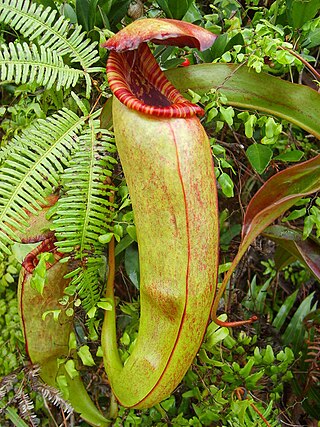
Nepenthes bokorensis is a tropical pitcher plant endemic to Cambodia. It is known from Mount Bokor in the south of the country, and an as yet undetermined specimen suggests that it may also be present in other parts of the Dâmrei Mountains of Kampot Province. The specific epithet bokorensis refers to both Mount Bokor and Bokor National Park.

Drosera gigantea, the giant sundew, is an erect perennial tuberous species in the carnivorous plant genus Drosera that is endemic to Western Australia. It grows in sandy soils at the margins of swamps and near granite outcrops along the Western Australian coast from Albany north to just south of Geraldton. D. gigantea produces small shield-shaped leaves along many lateral branches that look like a small tree. Individual plants can grow up to 0.2–1 m (0.7–3.3 ft) tall. Because of its tall, tree-like form, it is considered one of the largest Drosera species. It is also easily cultivated and enjoys damp, humid conditions often provided in greenhouses. White flowers emerge from August to November. The red tubers of this species can grow to be 3.8 cm (1.5 in) in diameter and may be a metre below ground.

Drosera meristocaulis is a perennial species in the carnivorous plant genus Drosera, the only member of the subgenus Meristocaulis. It is a small, rosette- and branched stem-forming sundew that has many morphological affinities to the Australian pygmy sundews. D. meristocaulis is wholly endemic to Pico da Neblina, an isolated mountain on the Brazil-Venezuela border.

Drosera derbyensis is a perennial carnivorous plant in the genus Drosera and is endemic to Western Australia. Its erect or semi-erect leaves are arranged in a rosette with one or more rosettes emerging from the root stock. The petioles are narrowly oblanceolate, 0.8–1.0 mm wide at the proximate end and 1.3–1.7 mm wide at the apex(wiki), narrowing to 0.5–0.7 mm at the laminar base. The petioles are frequently 35–45 mm long when the plant is in flower and are covered in white woolly non-dendritic hairs. The insect-trapping leaf lamina is orbicular and much shorter than the petioles at only 2–3 mm in diameter. The laminar adaxial surface is covered in insect-trapping glands. Each rosette produces 1–4 raceme inflorescences, which are 25–35 cm (10–14 in) long. Each inflorescence bears 30–50 white flowers, with flowering occurring from March to June. The upper portion of the scape and the abaxial surface of the sepals are covered with white woolly non-dendritic hairs. Its roots are fibrous. Drosera derbyensis grows in sandy soils in floodways or near rock outcrops from Derby to Beverley Springs in the Kimberley region.
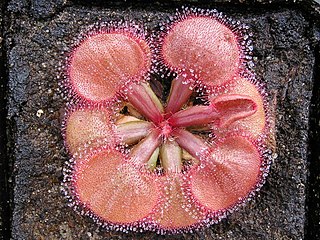
Drosera falconeri is a carnivorous plant in the family of Droseraceae. It is endemic to the Northern Territory of Australia.
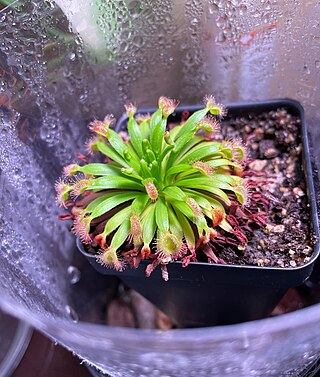
Drosera fulva is a carnivorous plant in the genus Drosera and is endemic to the Northern Territory in Australia. Its semi-erect or prostrate leaves are arranged in a compact basal rosette. Oblanceolate petioles emerging from the center of the rosette are typically 2–3 mm wide at its widest. Red carnivorous leaves at the end of the petioles are small and round at 2–3 mm in diameter. Inflorescences are 25–45 cm (10–18 in) long with white or sometimes pink flowers being produced on 50-or-more-flowered racemes from February to May.

Drosera kenneallyi is a carnivorous plant in the genus Drosera and is endemic to the Kimberley region in northern Western Australia. Its leaves are arranged in a compact basal rosette appressed to the soil. Narrowly oblanceolate petioles emerging from the center of the rosette are typically 1.5–2.2 mm wide at their widest. Red carnivorous leaves at the end of the petioles are small at 2–3 mm in diameter and elliptic to broadly ovate. Inflorescences are 12.5–20.5 cm (5–8 in) long with white flowers being produced on 10- to 20-flowered racemes from November to December.

Drosera lanata is a carnivorous plant in the genus Drosera and is endemic to the Northern Territory and Queensland in Australia. Its leaves are arranged in a compact basal rosette. Narrow linear petioles less than 2 mm wide emerge from the center of the rosette and hold carnivorous leaves at the end. Both petioles and the center of the rosette are densely covered in silvery dendritic hairs. These dendritic hairs afford the plant insulation and allow it to trap morning dew for additional moisture during the dry season. The leaf lamina is maroon-red and 2 mm long by 2.5 mm wide.

Drosera nivea is a species of carnivorous plant. It is a pygmy sundew and is native to Western Australia. The specific epithet nivea is derived from the Latin word niveus, meaning white, in reference to the colour of the plant's flower. It is closely related to Drosera citrina and has previously been considered a variety of D.citrina known as D. citrina var. nivea.

Drosera albonotata is a species of pygmy sundew native to Western Australia. It was first described by Alastair Robinson, Adam Cross, Manfred Meisterl and Andreas Fleischmann in 2018.























